Topics List
Sep. 4, 2023 Updated
Live Coverage: Launch of the X-Ray Imaging and Spectroscopy Mission (XRISM) and the Smart Lander for Investigating Moon (SLIM) onboard the H-IIA Launch Vehicle No. 47 [Rescheduled]
|
JAXA will provide the live coverage of the launch of the X-Ray Imaging and Spectroscopy Mission (XRISM) and the Smart Lander for Investigating Moon (SLIM) onboard the H-IIA Launch Vehicle No. 47 (H-IIA F47).
Broadcast Time: around 8:10 a.m. to 9:40 a.m. (JST) on September 7, 2023/ 23:10 p.m. on September 6 to 0:40 a.m. (UTC) on September 7, 2023 The broadcast date and time are subject to change. 
|
Nov. 28, 2022 Updated
GEOTAIL ends after over 30 years of observational operations
|
GEOTAIL is a joint Japan-US project to observe the Earth's magnetotail. The satellite was launched in July 1992 from Florida in the USA onboard the Delta-II launch vehicle. On a long elliptical orbit around the Earth, GEOTAIL conducted long-term observations for more than 30 years, and achieved ground-breaking results, in particular numerous discoveries in the Earth's magnetotail, such as demonstrating that magnetic reconnection occurs at the daytime boundary and tail of the Earth's magnetosphere, clarifying how ions and electrons behave in this region. GEOTAIL's operation for more than 30 years far exceeded the originally planned three-and-a-half-year mission period. However, by the end of June 2022, both the satellite's installed data recorders stopped operating. Due to lack of sufficient observation data, it was decided to terminate observation operations on November 28, 2022, and stop the operation of the spacecraft and radiowave transmission. The results of the mission will be summarised by the end of March next year. We would like to express our deepest gratitude to all the organisations and individuals who have cooperating in the operation of GEOTAIL so far. |
Mar. 28, 2022 Updated
Registration is NOW OPEN for The Ryugu AO
|
Finally, the Ryugu AO system starts proposal registration! To join the program, please create your account by March 25th. 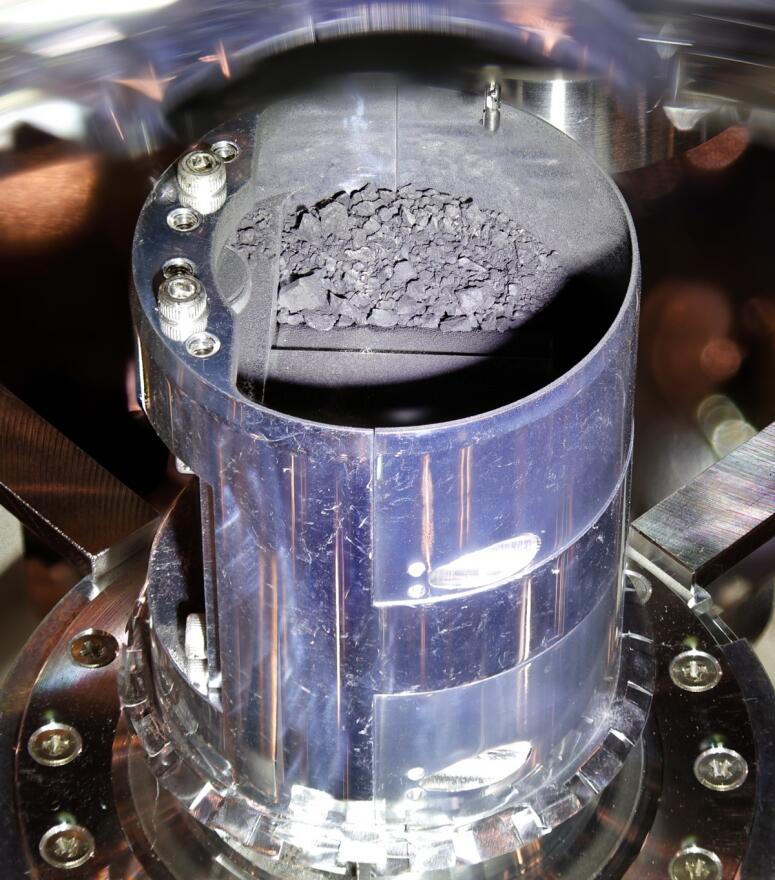
|
Feb. 14, 2022 Updated
Research published in “Science” asks how representative is the sample returned by Hayabusa2 of the entire asteroid?
|
The sample returned by Hayabusa2 from asteroid Ryugu is compared with observations of the asteroid from the Hayabusa2 spacecraft. The results of this analysis have been published in the US scientific journal, “Science” on February 10 (EST). 
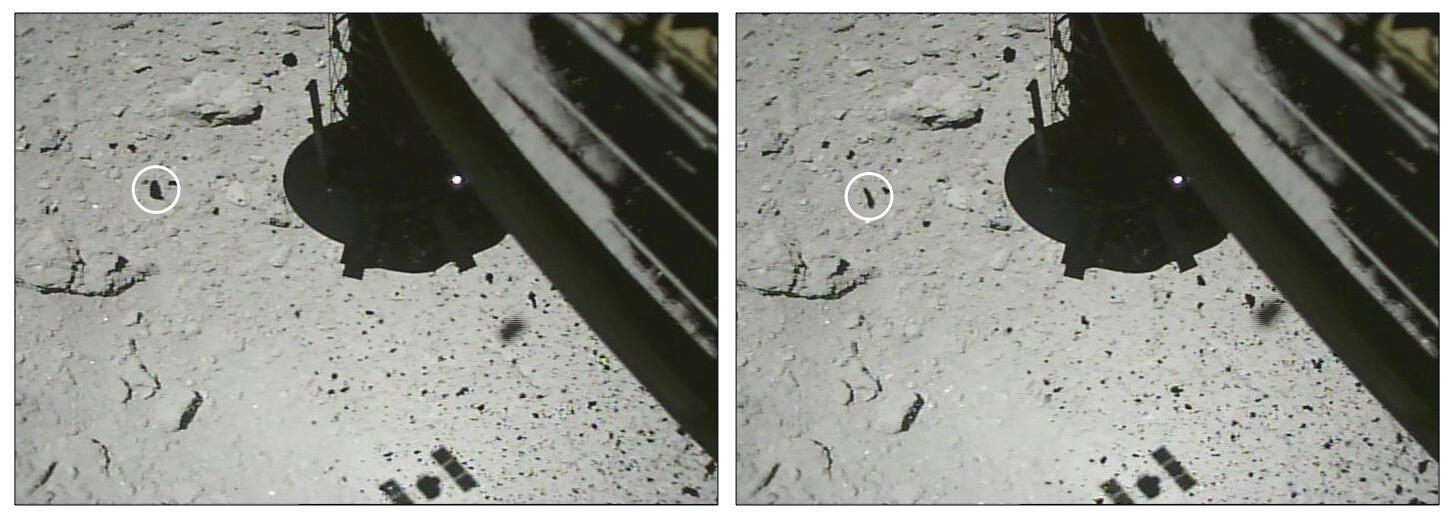
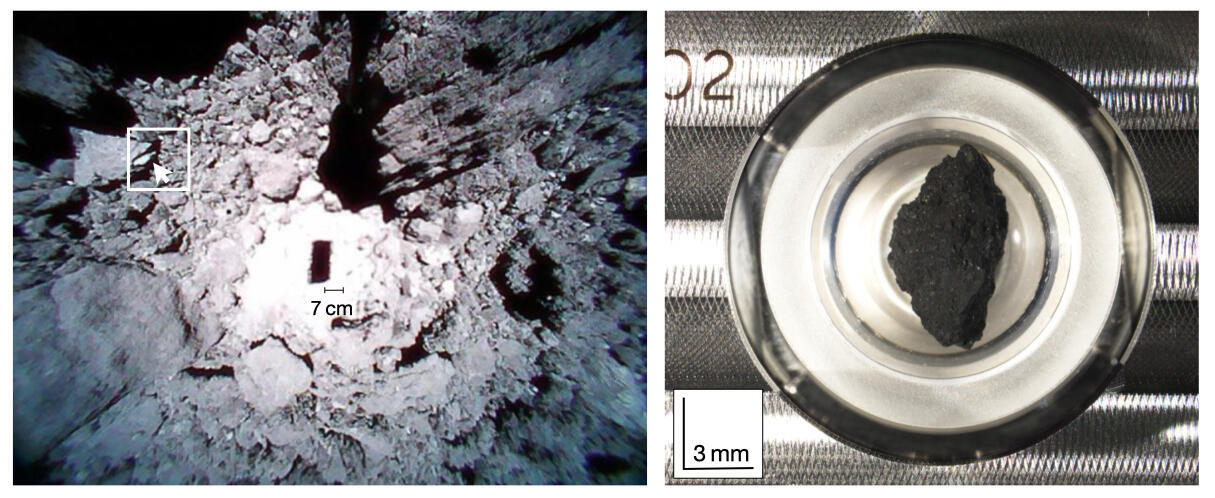
Click here for details: |
Dec. 21, 2021 Updated
Ryugu is a primitive asteroid rich in water and organic matter: A first look at the unprocessed carbonaceous asteroid sample returned by Hayabusa2, published in Nature Astronomy
|
The first results from the initial description of the sample from asteroid Ryugu returned by the Hayabusa2 spacecraft have been published in the British online journal, Nature Astronomy (December 21, 2021 JST). 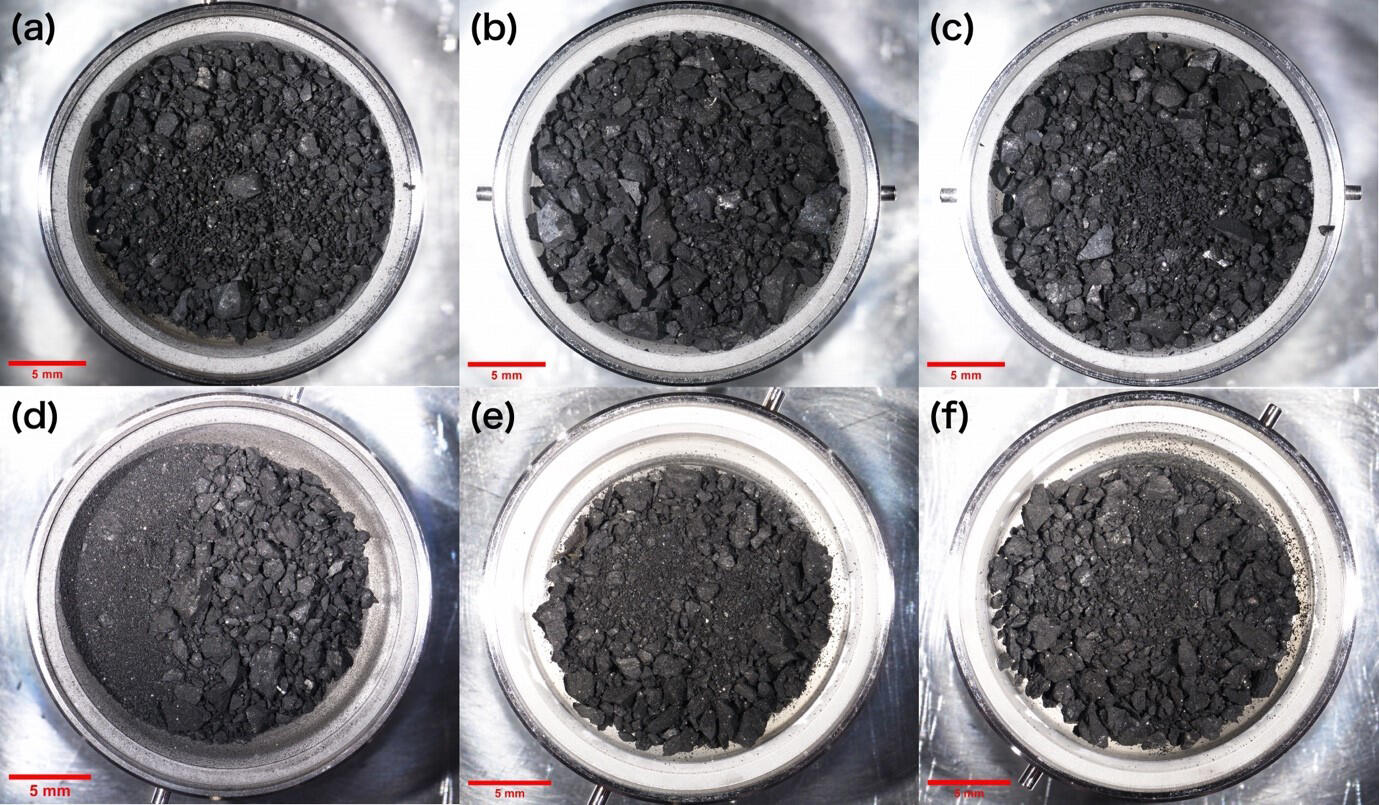
Click here for details: |
Aug. 5, 2021 Updated
A new map of temperatures in Jupiter’s upper atmosphere reveals a solution to the planet’s “energy crisis”
Overview: the aurora that heats a planetSitting more than five times the distance from the Sun as the Earth, Jupiter is not expected to be particularly warm. Based on the amount of sunlight received, the average temperature in the giant planet’s upper atmosphere should be about 200 K or a chilly -73 Celsius. Instead, the measured value sits around 700 K or 420 Celsius. The source of this global heat has remained elusive for 50 years, causing scientists to refer to the discrepancy as an “energy crisis” for the planet. Now research led by James O’Donoghue (JAXA) has found the likely source of Jupiter’s thermal boost. By creating the highest resolution global maps to date of the temperature of Jupiter’s upper atmosphere, the team has revealed that the main source of the extra heat is Jupiter’s powerful aurora. Movie: Jupiter is first shown in visible light for context before an artistic impression of the Jovian upper atmos-phere's infrared glow is overlaid. The brightness of the upper atmosphere corresponds to temperature. From hot to cold: white, yellow, bright red, dark red. The aurorae are the hottest regions and the animation shows how heat may be carried by winds away from the aurora and cause planet-wide heating. The end of the ani-mation shows the real data with a temperature scale, indicating the observed global temperatures measured in the study. A still image is shown in Figure 3. (Credit: J. O'Donoghue (JAXA)/Hubble/NASA/ESA/A. Simon/J. Schmidt) Auroras occur when charged particles are caught in a planet’s magnetic field. These spiral along the field lines towards the planet’s magnetic poles, striking atoms and molecules in the atmosphere to release light and energy. On Earth, this leads to the characteristic light show that forms the aurora borealis and australis. On Jupiter, the material spewing from its volcanic moon, Io, leads to the most powerful aurora in the Solar System and enormous heating in the polar regions of the planet. Although the Jovian aurorae have been a long-standing candidate heat source for the majority of the planet, observations have previously been unable to confirm or deny this until now. Research detailsThe team observed Jupiter with the 10-metre Keck II telescope on Mauna Kea in Hawai’i for five hours on two separate nights in April 2016 and January 2017. Using the Near-Infrared Spectrometer (NIRSPEC) on the Keck II, emission from H3+ ions in Jupiter’s atmosphere was detected from the planet’s poles down to the equator. H3+ ions are a major constituent of the ionized part of Jupiter’s upper atmosphere and the intensity of the emission can be used to derive the temperature of that region. Previous maps of the upper atmospheric temperature were formed using images consisting of only several pixels. This is not enough resolution to see how the temperature might be changed across the planet, providing few clues as to the origin of the extra heat. In order to improve the situation, the team took a two step approach. The first step was to utilise the power of the Keck II to take many more temperature measurements across the face of the planet. The second step was to only include a temperature measurement in the final map of the atmosphere if the uncertainty in the recorded value was less than 5%. 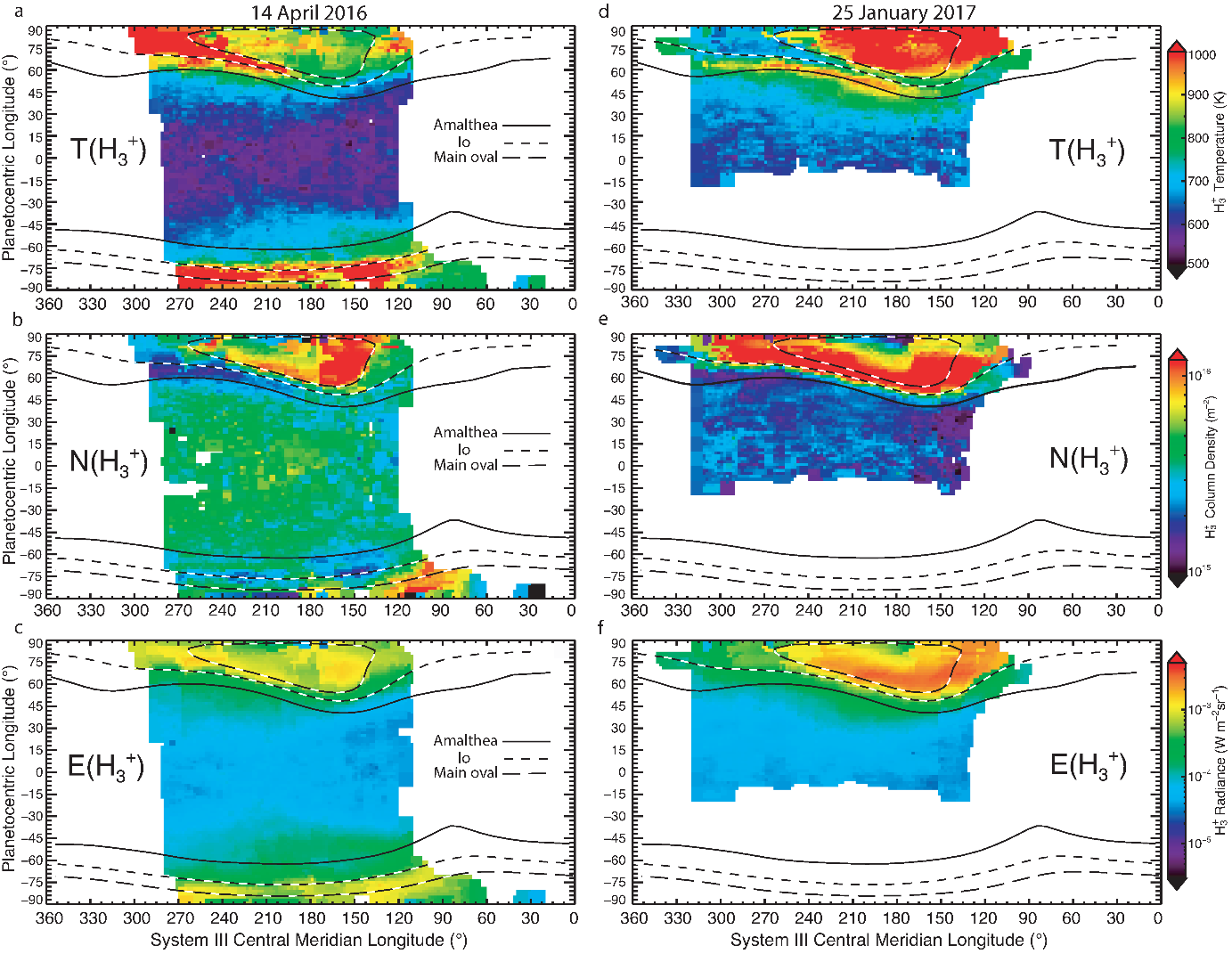
Figure 1: Temperature (top row), density (middle row) and radiance (lower row) of H3+ in Jupiter’s atmosphere (column-integrated). Long-dashed lines show the main region of the aurora, short-dashed line and solid line show the magnetic influence of the moons Io and Amalthea (Taken from O’Donoghue et al, 2021, Nature). To achieve this, the team created five maps of the atmospheric temperature at different spatial resolutions. The highest resolution map had an average temperature measurement for every 2 degrees longitude x 2 degrees latitude of the planet. Lower resolution maps averaged the temperature across regions 4 degrees x 4 degrees, 6 degrees x 6 degrees, 8 degrees x 8 degrees and 10 degrees x 10 degrees. If any temperature measurement in the highest resolution map had too high an uncertainty, the value from a lower resolution map with improved uncertainty would be substituted. The result was a map that combined the highest possible resolution with the lowest uncertainty in the measurements: the best of both worlds for analysis. “It took years of careful work to clean and map out the data and analyse it,” said James O’Donoghue. “The final products were temperature maps that are comprised of over ten thousand individual data points.” A clear trendThe temperature maps of Jupiter's upper atmosphere show clear gradients, with temperatures decreasing from the polar auroral regions to the equator. This demonstrated that Jupiter’s aurora was circulating auroral energy planet-wide, with winds carrying the heated atmosphere to lower latitudes and adjacent longitudes. The idea that the aurora could be the source of Jupiter’s mysterious energy had been proposed previously. However, global models of Jupiter’s upper atmosphere suggested that winds headed to the equator would be overwhelmed and redirected by west-ward winds driven by the planet’s rapid rotation. This would prevent the auroral energy from escaping the polar regions and heating the whole atmosphere. However, this new observational result suggests that such trapping is not occurring, and that the west-ward winds may be relatively weaker than expected compared with equatorward winds. 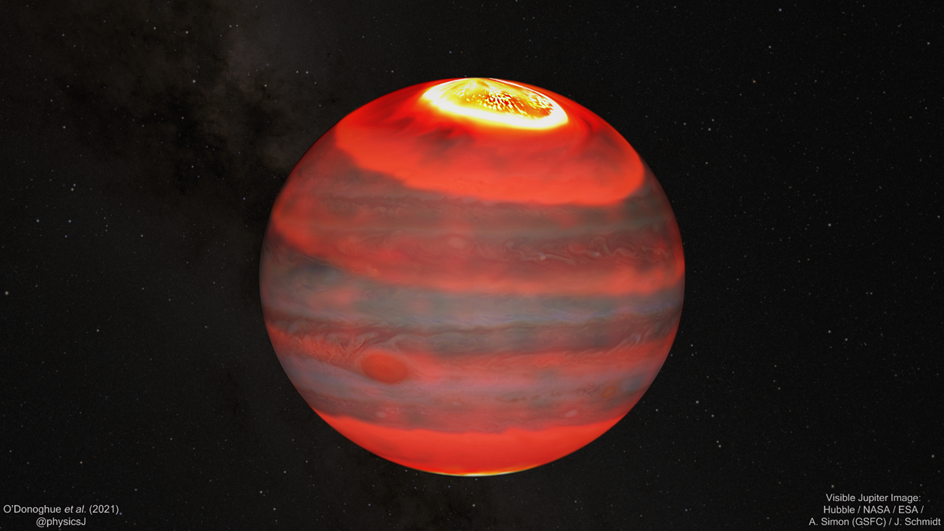
Figure 2: Jupiter is shown in visible light overlaid with an artistic impression of the Jovi-an upper atmosphere's infrared glow. The brightness of the upper atmosphere corre-sponds to temperature. From hot to cold: white, yellow, bright red, dark red. The aurorae are the hottest regions and show how heat may be carried by winds away from the auro-ra and cause planet-wide heating.
From orbit around the Earth, JAXA’s Hisaki satellite has observed the aurora-generating magnetic field around Jupiter since the mission’s launch in 2013. This long term monitoring has revealed that Jupiter’s magnetic field is strongly influenced by the solar wind; a stream of high energy particles that emanates the Sun. The solar wind carries its own magnetic field and when this meets Jupiter’s planetary field, the latter is compressed. Further evidence for this interaction and the resultant heating was found when the team observed an extended high temperature region of gas that appeared to be propagating from the aurora. At the time of observation, pressure from the solar wind was particularly high at Jupiter and the field compression is likely to have created an enhanced aurora. The resulting heat wave was the structure spotted by the team as it began to move away towards lower latitudes. "It was pure luck that we captured this potential heat-shedding event,” notes O’Donoghue. “If we’d observed Jupiter on a different night, when the solar wind pressure had not recently been high, we would have missed it!” The discovery of the temperature gradient extending between Jupiter’s auroral region and equator may end the planet’s “energy crisis”. However, while auroras are expected phenomenon on giant gaseous words, the complex state of their winds may determine how effective the heat source is on different planets. Journal paper informationArticle title: Global upper-atmospheric heating on Jupiter by the polar aurorae Journal title: Nature Date of publication: 5 August 00:00 (JST)
DOI: 10.1038/s41586-021-03706-wExternal Link
Authors:
Links:
|
Dec. 7, 2020 Updated
Gas sampling from the Hayabusa2 sample container
|
This morning (December 7), the recovery team confirmed that the re-entry capsule was properly sealed and completed the gas sampling work. Although we analyzed the collected gas and evaluated the data, we have not yet determined whether it originates from the sample from Ryugu. A detailed analysis will continue in Japan. 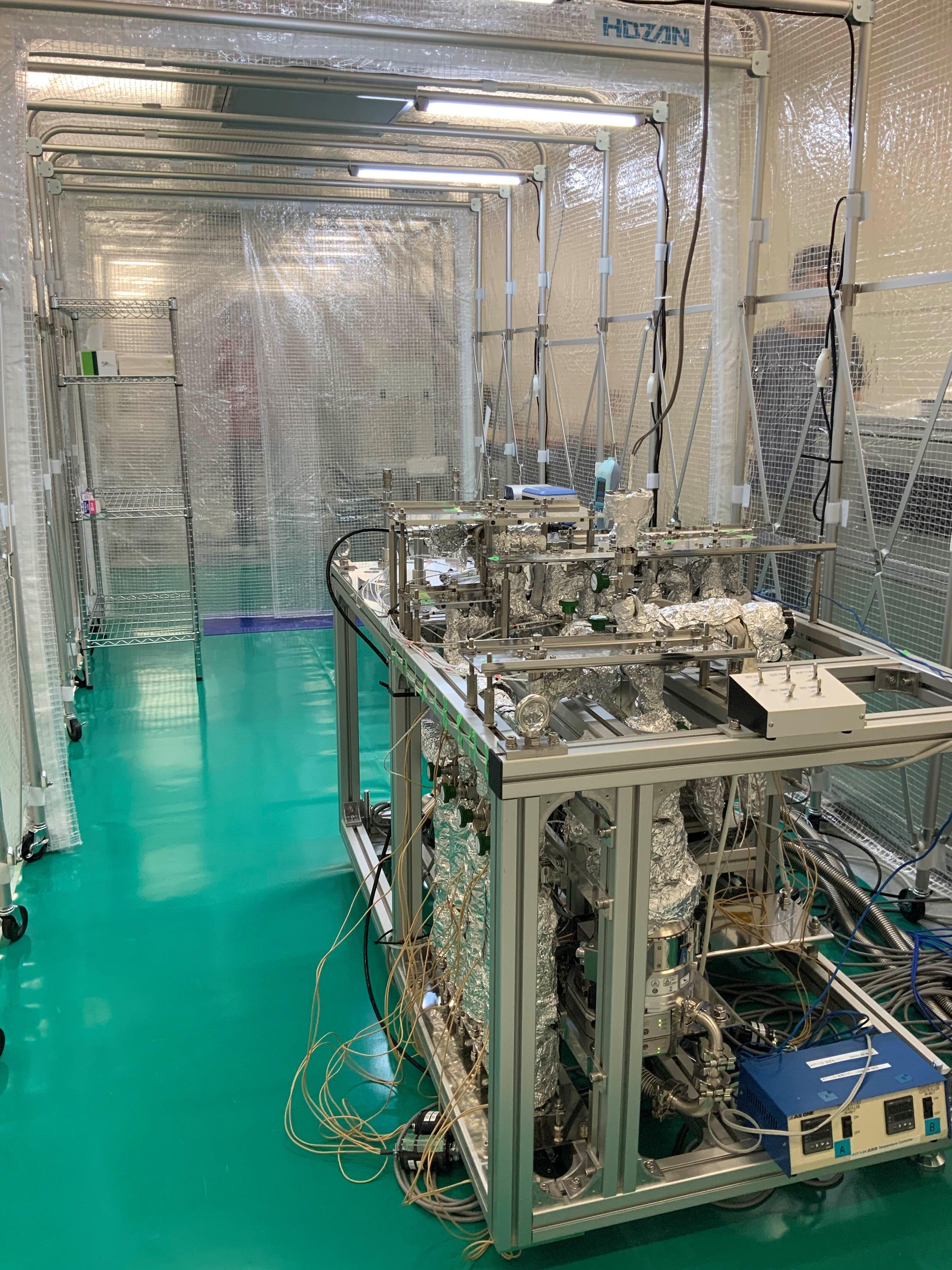
Equipment brought to Australia for gas analysis.
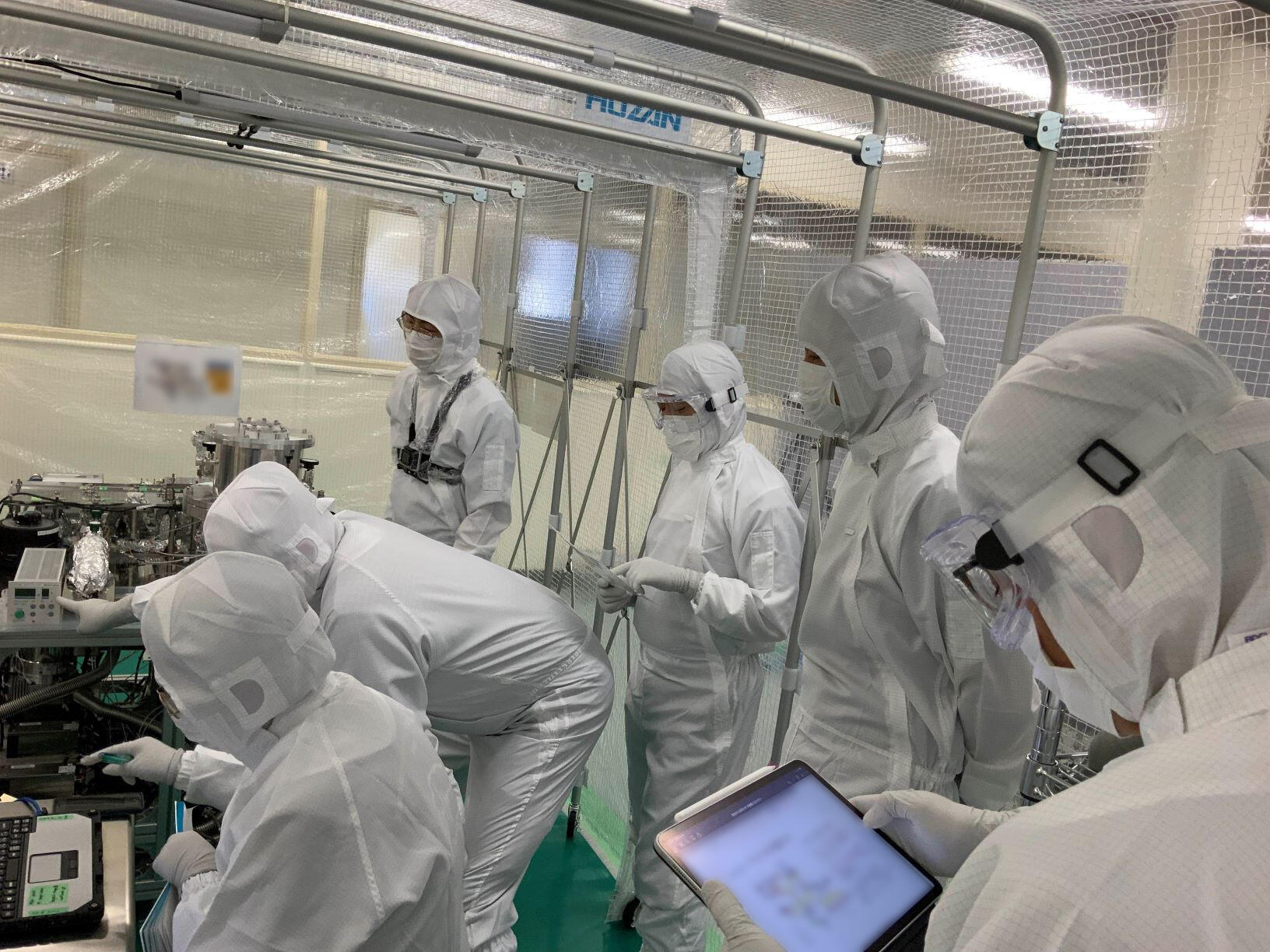
After the completion of the set-up of the clean booth, a test run is underway.
|
Dec. 6, 2020 Updated
Completion of Transportation of Hayabusa2 Re-entry Capsule to QLF
|
The helicopter carrying Hayabusa2 re-entry capsule arrived at the Quick Look Facility (QLF) at 8:03 December 6, 2020 (JST). 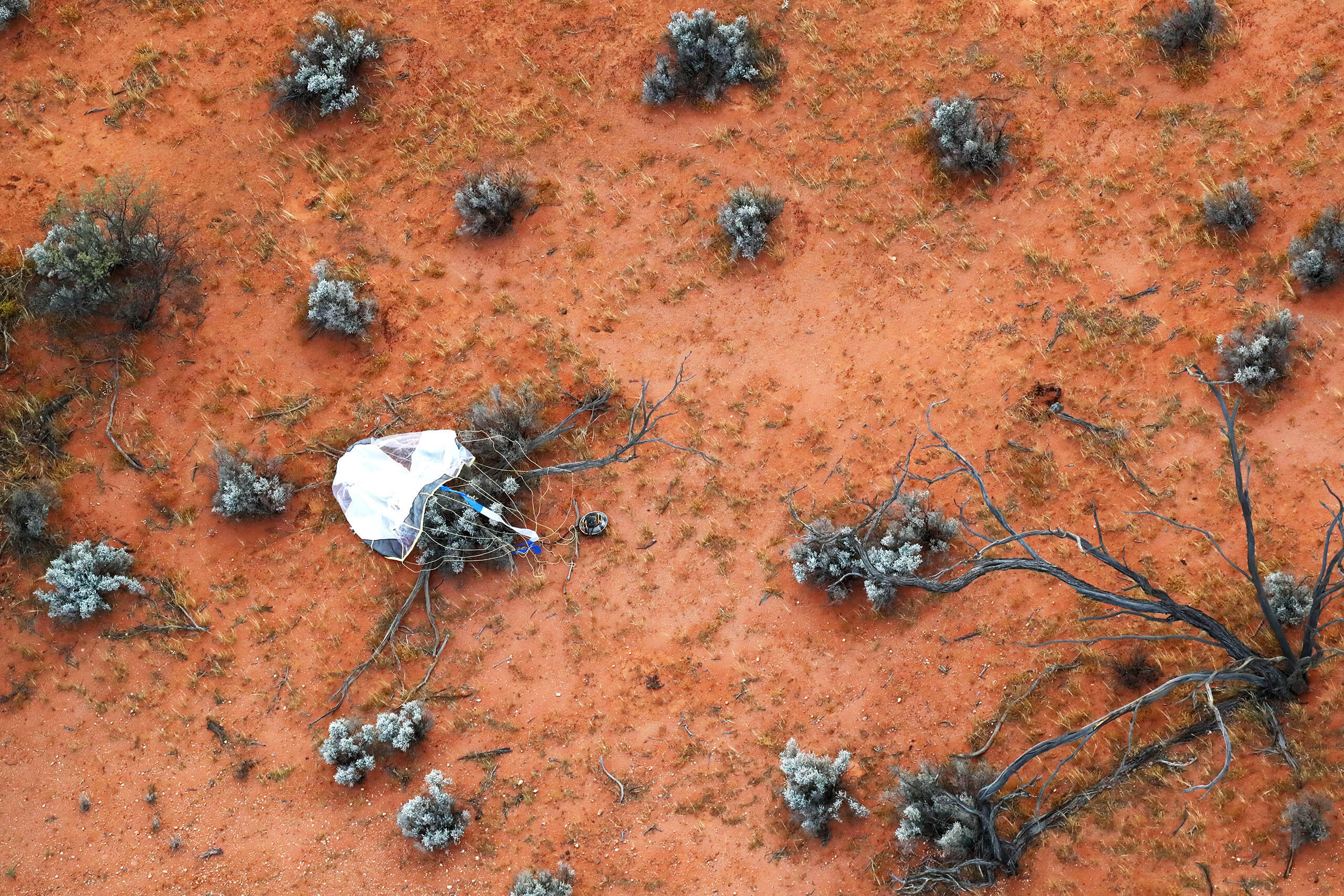
Re-entry capsule collection |
Dec. 6, 2020 Updated
Result of Hatabusa2 Re-entry Capsule Search
|
Hayabusa2 re-entry capsule re-entered the atmosphere at around 2:28 a.m. on December 6, 2020 (JST). The Japan Aerospace Exploration Agency (JAXA) searched for the capsule by helicopter and located its landing site in WPA, Australia at 4:47 December 6, 2020 (JST). 
Fireball taken from Coober Pedy 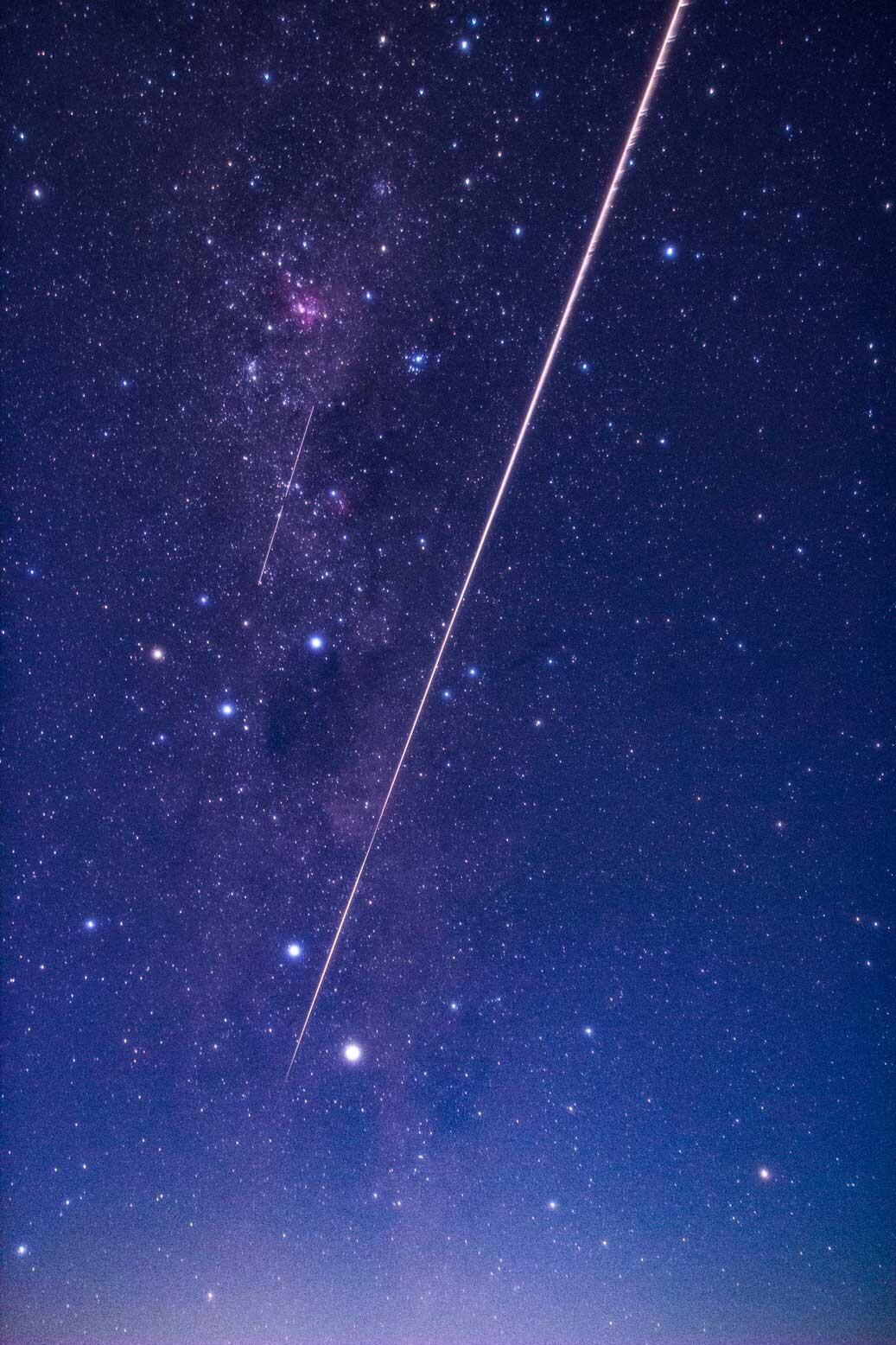
Fireball taken from Coober Pedy 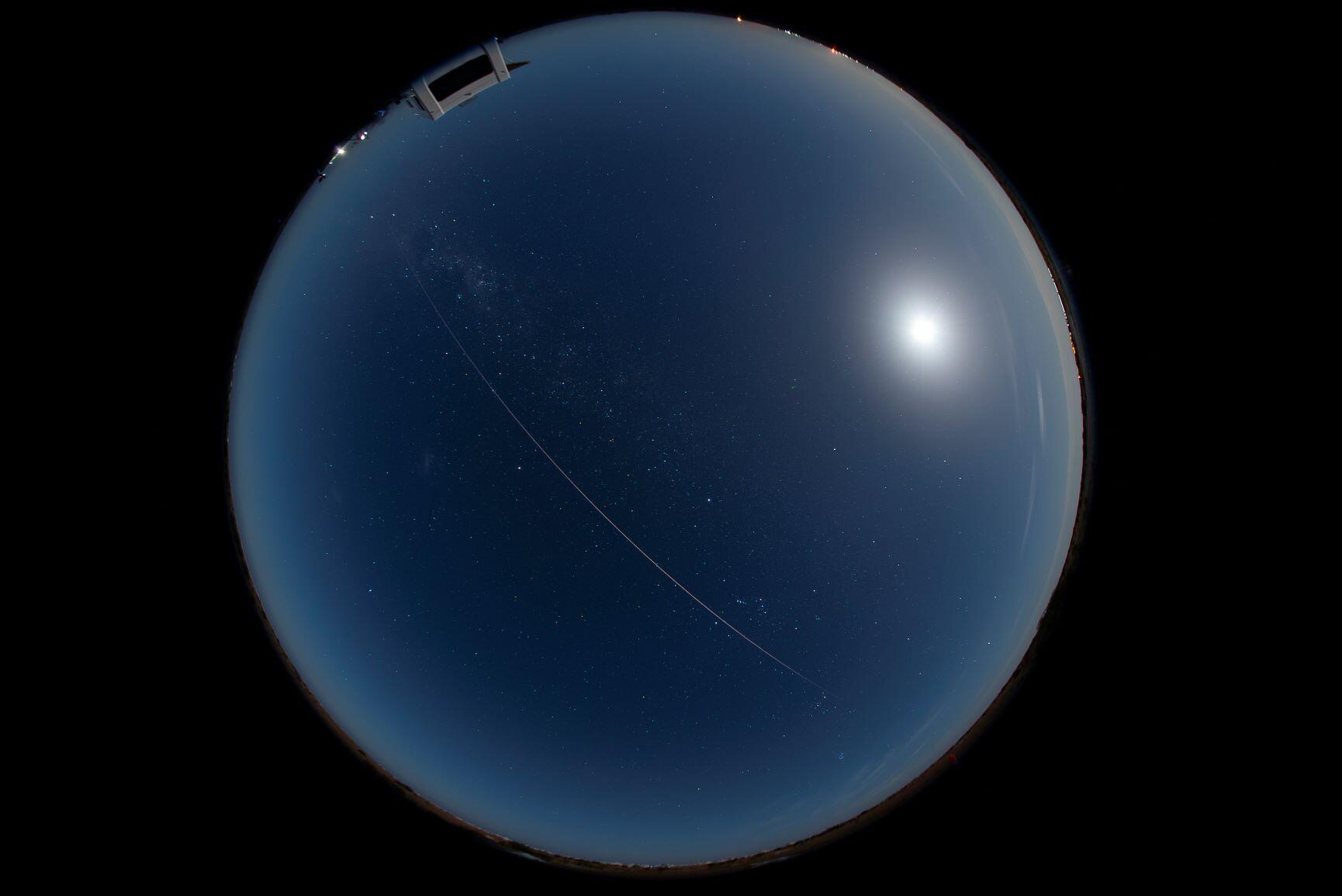
Fireball taken from Coober Pedy 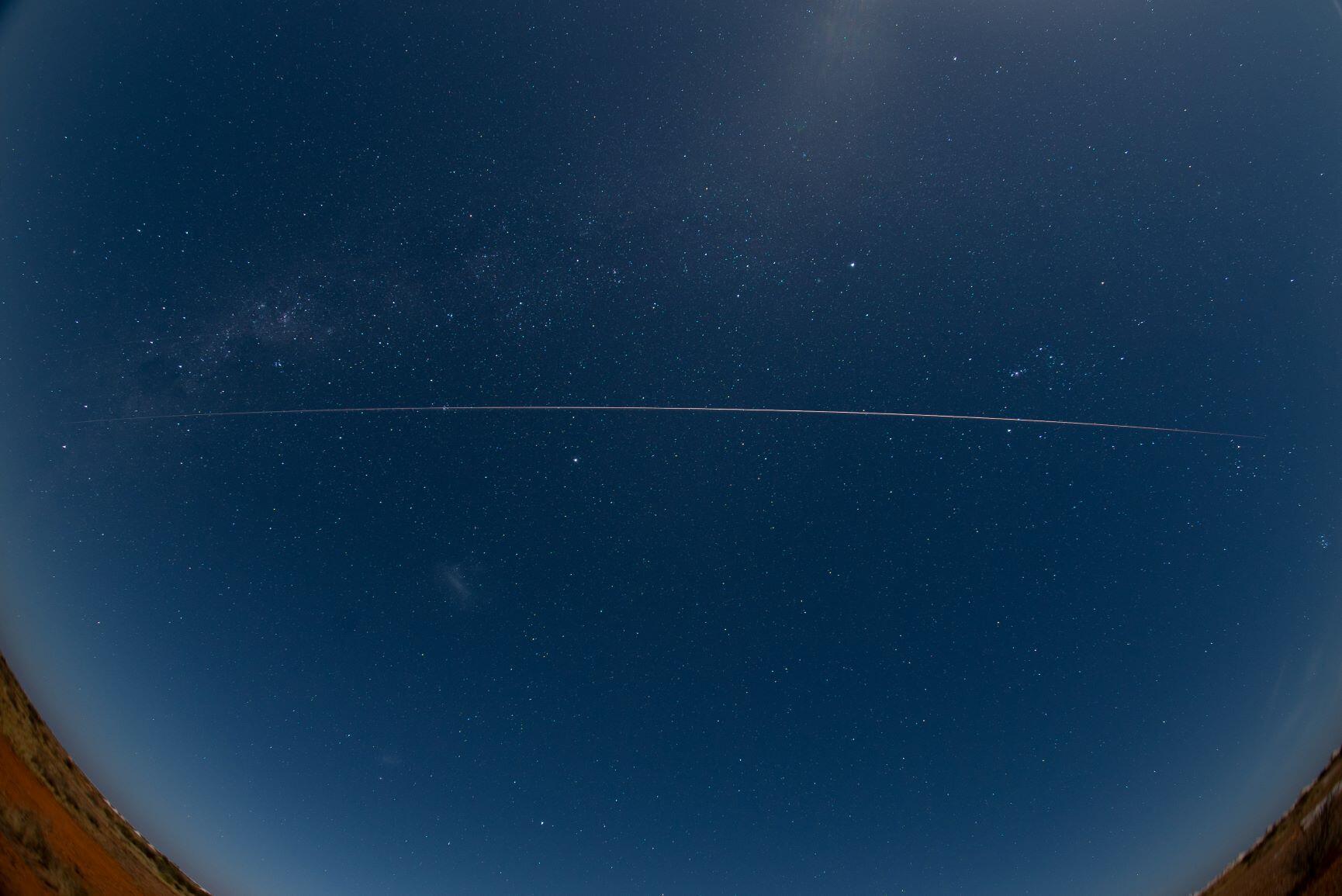
Fireball taken from Coober Pedy 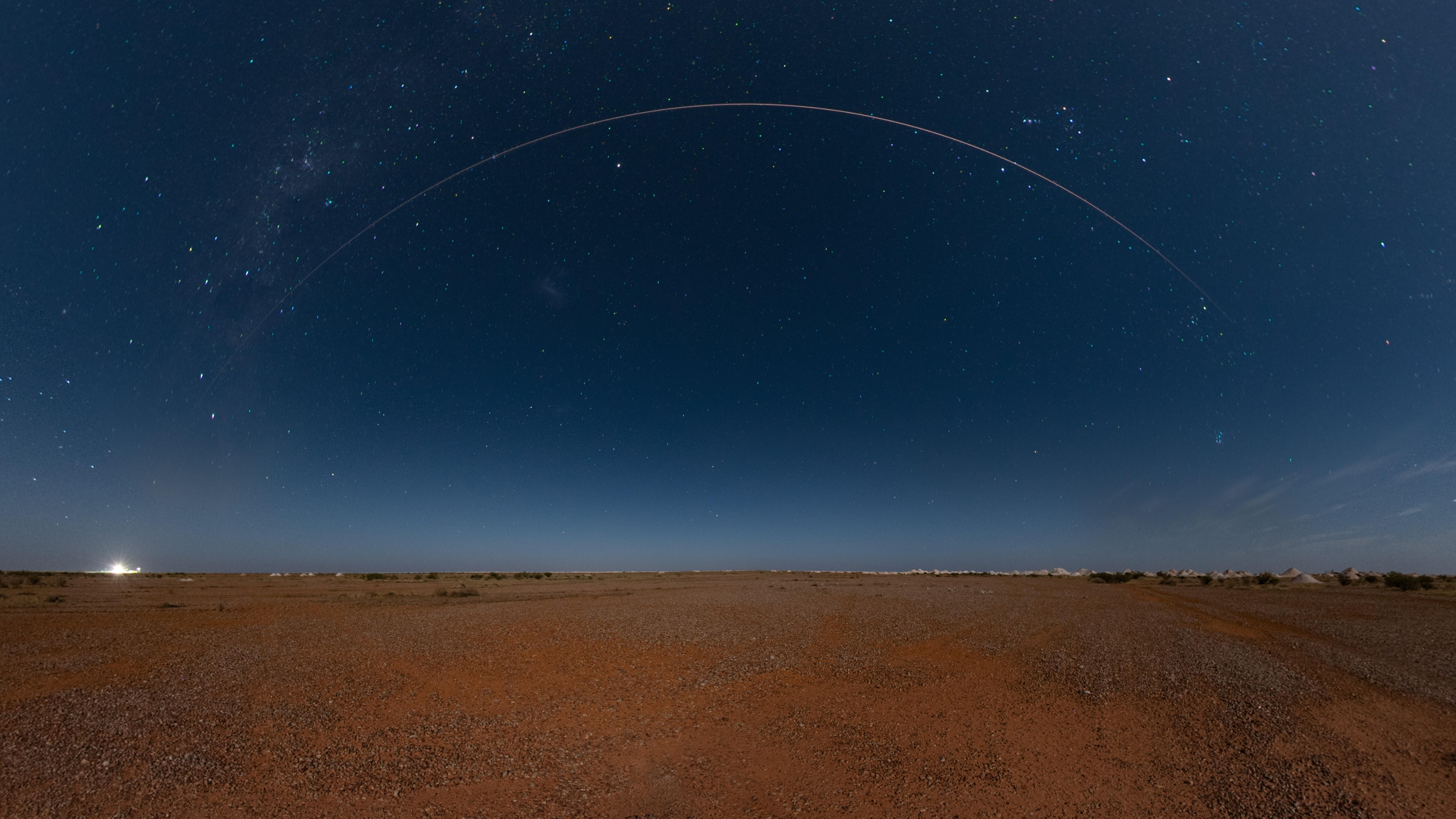
Fireball taken from Coober Pedy |
Dec. 5, 2020 Updated
Successful Separation of Hayabusa2 Re-entry Capsule
|
It was confirmed from telemetry and Doppler data that Hayabusa2 re-entry capsule separated from the Hayabusa2 spacecraft as planned at 14:35 on December 5, 2020 (JST). |
May 22, 2020 Updated
[HAYABUSA2 PROJECT] Messages from our members overseas
|
When the start of the second ion engine operation on May 12 was announced to Hayabusa2 project members overseas, they showered the local team with messages! As the current situation with the novel coronavirus is creating difficult times worldwide, we would like to share these encouraging replies that uplifted the team here in Japan. |
![[HAYABUSA2 PROJECT] Messages from our members overseas](https://global.jaxa.jp/projects/hayabusa2/images/topics_20200522_hayabusa2.jpg)
|
|---|
Jun. 27, 2019 Updated
JAXA and CNES Sign Implementing Arrangement on Martian Moons eXploration (MMX) and Hayabusa2
|
Japan Aerospace Exploration Agency has agreed to cooperate with Centre National d'Etudes Spatiales (CNES) on the study-phase activities in JAXA’s Martian Moons eXploration(MMX) mission and analysis of Hayabusa2-returned samples. 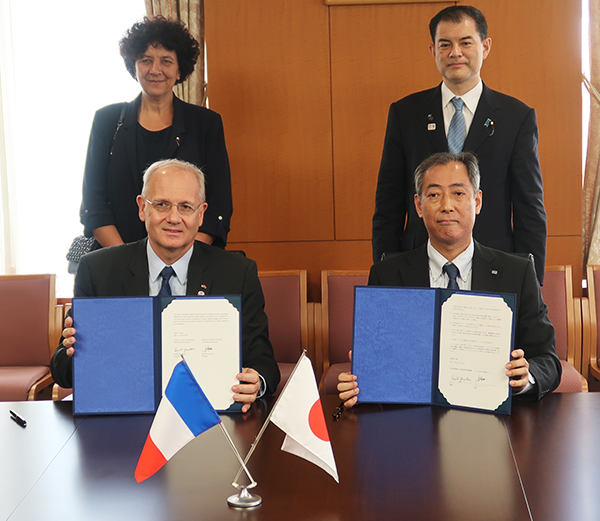

About the Implementing Arrangement concerning cooperative activities related to Martian Moon eXploration (MMX) mission studies
The MMX mission is planned to observe Mars’ two moons, Phobos and Deimos and to collect surface material from one of the moons to bring back to Earth. It aims to clarify the origin of the Martian moons and the process of evolution for Mars region and to improve technologies required for future exploration.
For more information on MMX, visit: About the Implementing Arrangement concerning cooperative activities related to analysis of Hayabusa2 return samples by MicrOmega at JAXA Extraterrestrial Sample Curation Center
Hayabusa2 is a successor of Hayabusa. By investigating the asteroid Ryugu(type-C asteroid)and collecting samples for return to Earth, it aims to clarify the origins and evolution of Earth as well as organic materials that formed the oceans and the life.
For more information on Hayabusa2, visit: |
Jun. 20, 2019 Updated
JAXA and DLR Make and Sign Implementing Arrangement on Martian Moons eXploration (MMX)
|
Japan Aerospace Exploration Agency has agreed to cooperate with German Aerospace Center (DLR) on the study-phase activities in JAXA's Martian Moons eXploration (MMX) mission. 
The MMX mission is planned to observe Mars' two moons, Phobos and Deimos and to collect surface material from one of the moons to bring back to Earth. It aims to clarify the origin of the Martian moons and the process of evolution for Mars region and to improve technologies required for future exploration. DLR will contribute to this mission by conducting studies of the rover which is to be equipped on MMX jointly with Centre National d'Etudes Spatiales (CNES) and by providing JAXA with opportunities of experiments using the Drop Tower in Germany. DLR will also support German scientists for their participation in the MMX mission. |
Jun. 17, 2019 Updated
Agreement with European Space Agency (ESA) for cooperation on the X-Ray Imaging and Spectroscopy Mission: XRISM
|
Japan Aerospace Exploration Agency has agreed to cooperate with European Space Agency (ESA) on the X-Ray Imaging and Spectroscopy 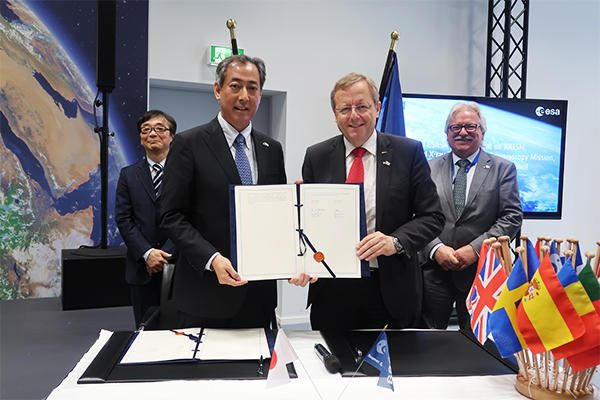
The XRISM project, kicked off in 2018, is the seventh X-ray astronomy satellite program of the Institute of Space and Astronautical Science, JAXA. It aims at the early recovery of the prime science objective "to solve outstanding astrophysical questions with high resolution X-ray spectroscopy" of ASTRO-H whose operation was ceased in 2016. |
Apr. 24, 2019 Updated
CLASP2 Rocket Experiment Launched
|
The CLASP2 sounding rocket experiment launched on April 11, 2019 at 10:51 a.m. MDT (01:51 a.m. JST on April 12) from the White Sands Missile Range, New Mexico, USA. It reached 274 km at maximum altitude and observed the Sun for 6 minutes from above 160 km. After the observations, the instrument parachuted down to the White Sands Desert, and was carried back to the laboratory. All the data stored in the instrument were recovered successfully. 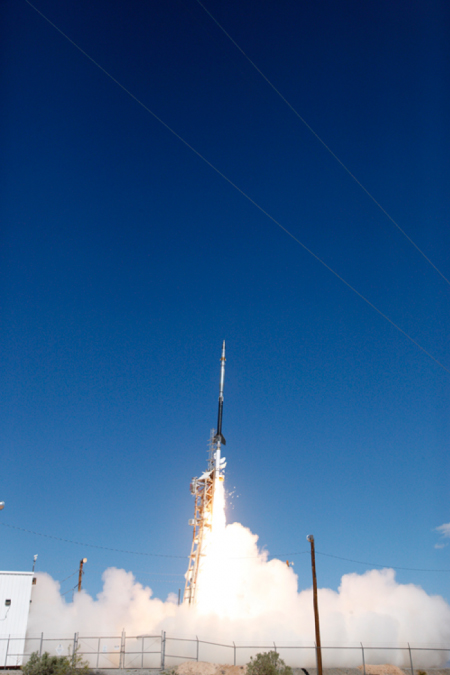
CLASP2 Sounding Rocket launch. (credit: US Army Photo, White Sands Missile Range) |
Apr. 4, 2019 Updated
[HAYABUSA2 PROJECT] SCI (Small Carry-on Impactor) Operation Schedule
|
The Small Carry-on Impactor (SCI) operation will take place between April 3 – 6. This is an impact experiment to create an artificial crater in a designated area. |
![[HAYABUSA2 PROJECT] SCI (Small Carry-on Impactor) Operation Schedule](https://global.jaxa.jp/projects/hayabusa2/images/topics_20190403_sci_schedule_e.jpg)
|
|---|
Mar. 28, 2019 Updated
[HAYABUSA2 PROJECT] Revised illustrations of Hayabusa2
|
At the beginning of the Hayabusa2 Project, realistic illustrations were drawn by Akihiro Ikeshita. These illustrations have now been revised to match the actual asteroid Ryugu. |
![[HAYABUSA2 PROJECT] Revised illustrations of Hayabusa2](https://global.jaxa.jp/projects/hayabusa2/images/topics_20190328_illustration.jpg)
|
|---|
Oct. 20, 2018 Updated
MIO En Route to Mercury
|
BepiColombo mission successfully took off at 10:45:28 am, October 20, in Japan Time, 2018. From the Guiana Space Center in French Guiana, the ESA's Mercury Planetary Orbiter (MPO) and JAXA's MIO, Mercury Magnetospheric Orbiter were launched aboard the Ariane 5 rocket at 10:45:28 pm in local time, 2018.
|

|
|---|
Jun. 26, 2017 Updated
B17-04 Scientific Balloon Testing
|
On June 24, 2017, at 3:33 a.m. JAXA launched B17-04, the second of the first series of Japanese fiscal 2017 balloon tests. When fully deployed, a 5,000-cubic-meter aerostatic balloon extends a 23-meter diameter. Built with new load tapes*, B17-04 was released from the Taiki Aerospace Research Field and ascended at 330 meters/m. JAXA is granted use of the Taiki Aerospace Research Field based on JAXA—Taiki-cho collaboration initiative.
|
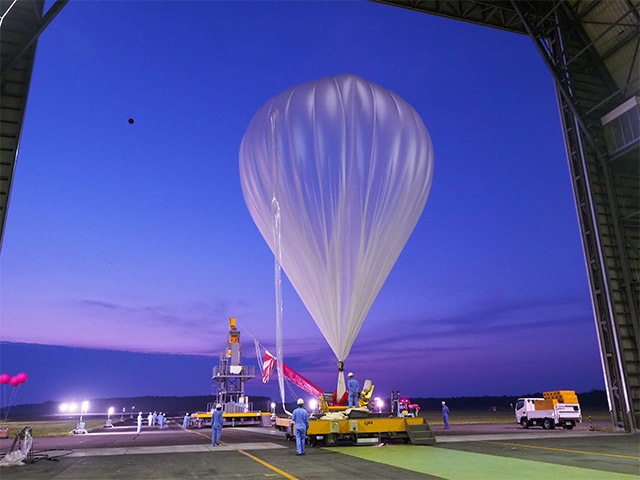
|
|---|
Jun. 23, 2017 Updated
B17-02 Scientific Balloon Test
|
On June 23, 2017, at 4:47 a.m. JAXA launched B17-02, the first scientific balloon of the series of Japanese fiscal 2017 balloon test operations. The balloon was set aloft from the Taiki Aerospace Research Field, premises that JAXA uses based on JAXA—Taiki-cho collaboration initiative. The objective is capturing sampling of stratospheric microorganisms.* A giant scientific balloon 30,000 cubic meters in maximum volume, 42 meters in radius of the circular cross-section, rose approximately at 330 meters/m.
|

|
|---|
Mar. 29, 2017 Updated
Arase off to Science Operations Phase
|
JAXA confirmed completion of the commissioning phase of ARASE, formerly known as ERG, Exploration of energization and Radiation in Geospace. ARASE has entered its science operations phase. The call was made as the following procedure took place as scheduled and was confirmed; the satellite post launch orbital systems are in place, their functions are determined as fine, all monitoring instruments are installed, and the motions of the monitoring equipment are checked. |

|
|---|
Jan. 23, 2017 Updated
Arase critical operation phase successfully completed!
|
JAXA confirmed completion of the critical operations phase of Arase (ERG), Exploration of energization and Radiation in Geospace. It results from a sequence of significant tasks that occurred as anticipated: perigee up maneuvers and extension of its wire antennae and masts. |
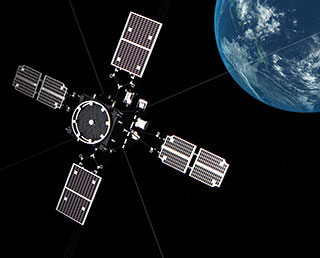
|
|---|
Dec. 20, 2016 Updated
Success of Epsilon-2 Launch with ERG Aboard
|
JAXA successfully launched the second Epsilon Launch Vehicle with Exploration of energization and Radiation in Geospace (ERG) aboard at 8:00 p.m. on December 20, 2016 (JST) from the Uchinoura Space Center. The launch vehicle flew as planned, and at approximately 13 minutes and 27 seconds after liftoff, the separation of ERG was confirmed. The signals were received in the Santiago Ground Station, the Republic of Chile at 8:37 p.m. (JST). ERG's solar array paddles have been deployed as planned.
Also, ERG has completed the attitude control based on the sun acquisition. |
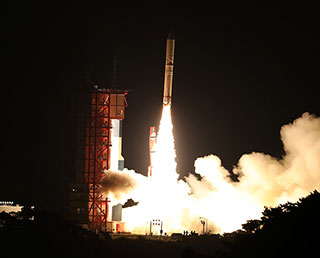
|
|---|
Dec. 19, 2016 Updated
Epsilon-2/ERG launch time decided! Live broadcast from 7:40 p.m. on December 20 (Tue.)
|
The launch time of the second Epsilon Launch Vehicle with Exploration of energization and Radiation in Geospace (ERG) was set for 8:00:00 on December 20 (Tue.), 2016 (Japan Standard Time). |
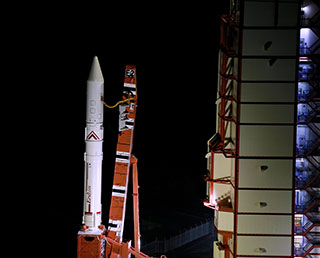
|
|---|
Nov. 15, 2016 Updated
The Launch date of the Epsilon-2 with the ERG satellite on board- December 20
|
JAXA announced that the second Epsilon Launch Vehicle with Exploration of energization and Radiation in Geospace (ERG) on board will be launched sometime between 8 p.m. to 9 p.m. on December 20, 2016 (Japan Standard Time). Live launch coverage from the Uchinoura Space Center will be carried on YouTube. More detail will be available shortly. |
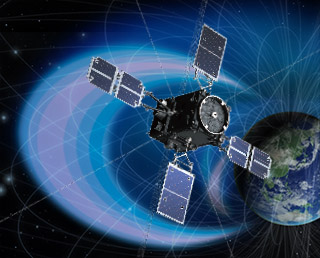
|
|---|
Oct. 24, 2016 Updated
"ERG" Put on View to Media
|
On October 20, "ERG", the Exploration of energization and Radiation in Geospace was shown to the media in the Uchinoura Space Center, Kimotsuki-cho, Kimotsuki-gun, Kagoshima. |
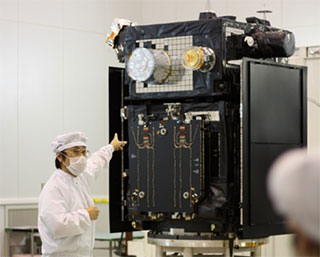
|
|---|
Sep. 30, 2016 Updated
Geospace satellite "ERG" released to the media
|
On September 29 (Thu.), the Exploration of energization and Radiation in Geospace "ERG" made its appearance to the press at the Sagamihara Campus. |
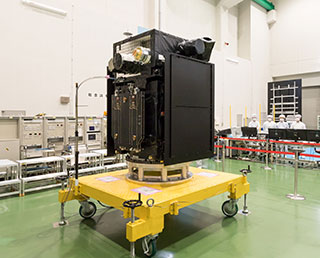
|
|---|
Jul. 22, 2016 Updated
The Magnetosphere Has a Large Intake of Solar Wind Energy
|
Solar wind forms the energy source for aurora explosions. How does the Earth’s magnetosphere take in the energy of the solar wind? An international team led by Hiroshi Hasegawa and Naritoshi Kitamura (ISAS/JAXA) analyzed data taken by the US-Japan collaborative mission GEOTAIL and NASA’s MMS satellites and revealed that the interaction between the magnetic fields of Earth and the Sun, or more precisely the phenomenon known as magnetic reconnection, can feed the aurora explosions. |
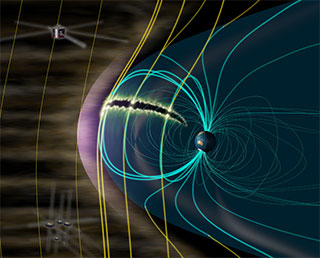
|
|---|
Jun. 14, 2016 Updated
Scientific balloon B16-01 experiment completed - High altitude flight test for Mars probe airplane
|
JAXA conducted the second balloon release of the first scientific balloon experiment in JFY 2016 on June 12 (Sun.), 2016, aiming at a high-altitude flight test for a Mars probe airplane. |
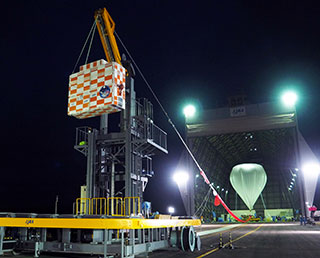
|
|---|
Jun. 8, 2016 Updated
Scientific balloon experiment B16-02 to capture microorganisms in the stratosphere
|
JAXA released the first scientific balloon in Japan Fiscal Year 2016 from the Taiki Aerospace Research Field, which is a base for cooperation between the host town and JAXA, at 3:43 a.m. on June 8 (Wed.), 2016. The purpose of this experiment is to capture microorganisms in the stratosphere. The balloon used this time is a large-size one with a maximum expansion volume of 15,000 cubic meters (33.5 meters in diameter), and it ascended at a speed of 300 meters/minute.
|
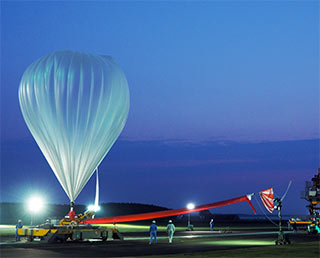
|
|---|
Feb. 25, 2016 Updated
Let Geospace satellite “ERG” carry your support message!
|
We are inviting you to have your message travel on the ERG satellite to explore the Van Allen belts, which is the last frontier in space around
the Earth. |

|
|---|
Aug. 24, 2015 Updated
Scientific balloon experiment BS15-07 and completion of the first series of balloon experiments in JFY2015
|
JAXA released the balloon “BS15-07” from the Taiki Aerospace Research Field at 5:02 a.m. on Aug. 22 (Sat.), 2015, aiming at verifying onboard instruments and operation of the satellite “EGG”*, which will be deployed from the International Space Station (ISS). The balloon was 11 meters in diameter when it was fully expanded, and it was ascending at a speed of about 380 meters per minute.
|
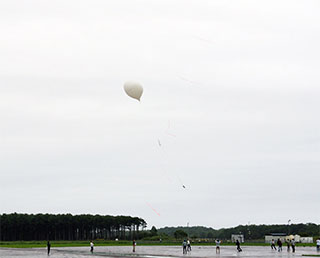
|
|---|
Aug. 7, 2015 Updated
Completion of Scientific balloon experiment BS15-03
|
JAXA released the balloon "BS15-03" from the Taiki Aerospace Research Field at 4:12 a.m. on Aug. 6 (Thu.), 2015, for the purpose of cryogenic sampling in the atmosphere at the stratosphere. The volume of the balloon when it was fully expanded was 100,000 m3 (with a diameter of 63.4 m), and it was ascending while gathering the atmosphere of the stratosphere.
|
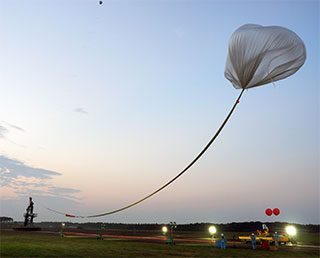
|
|---|
May 15, 2015 Updated
Scientific balloon experiment in Australia
|
On May 12, JAXA conducted a scientific balloon experiment in cooperation with
some universities including Kobe University and Nagoya University from the balloon release base of the University of New South Wales, Australia.
The experiment aims at elucidating the spatial structure of a celestial body and the gamma-ray emission mechanism by attaining high resolution
observations using the emulsion gamma-ray telescope of Kobe and Nagoya Universities. |
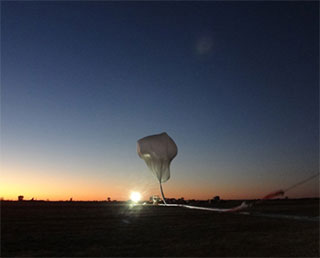
|
|---|
Sep. 9, 2010 Updated
Scientific balloon experiment BS10-06 completed
|
At 5:38 a.m. on September 8, 2010, JAXA released the fourth balloon of the second balloon experiment in Japan Fiscal Year 2010 from the Taiki Aerospace Research Field, the base of the collaborative work. The release experiment, called BS10-06, aimed at testing the high-altitude thin film balloon flight performance and observing the ozone and atmospheric gravitational waves. The balloon that was expanded to its full capacity of 60,000 m3 was made of a thin film for high altitude with a thickness of 3.4 micrometers, and it ascended about 300 meters per minute. |

|
|---|